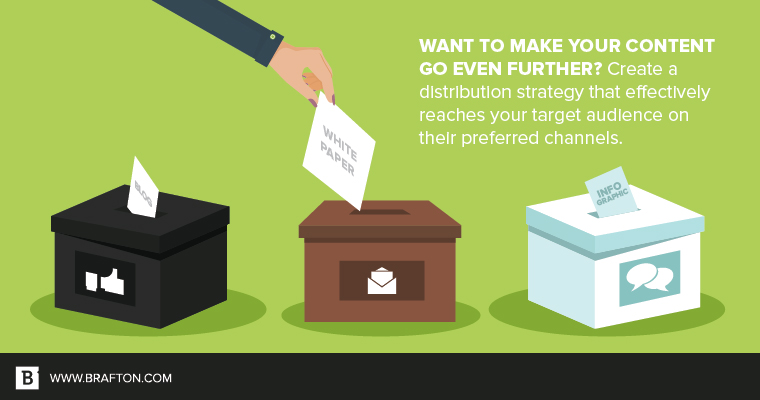Remember that famous movie tagline, “If you build it, he will come.”
Well, it’s safe to say the person who said that was not a content marketer.
Sure, you’re not building a baseball field to summon the ghosts of players past. But you are building something important – your content.
On the other hand, just because you’re building it doesn’t mean prospects are going to come swooping in, ready to devour what you’re giving them. No matter how engaging, informative or just downright awesome your content is, if you’re not doing anything with it, no one is going to find it.
This is why you’ve got to distribute your content, and you’ve got to do it effectively. This is especially true for B2B marketers, as reaching your target audience often requires a more detailed and refined process.
“Simply creating content and then sticking it in a box is not an effective way to get ROI for your investment,” said Brafton Senior Social Media Strategist Walt Clark. “You need to get your content in front of your target audience somehow.”
But what is content distribution?
Is it posting your content on your website or social media pages, or sending it via email to your B2B audience? Well, yes, it is that, but it’s also a lot more.
Just blindly posting your content on all of your available channels isn’t going to get you anywhere. If you want to distribute your content successfully, you have to create a strong distribution strategy that reaches your target audience through the right channels.
Simply creating content and then sticking it in a box is not an effective way to get ROI for your investment.
The importance of a distribution strategy
When I say you should spend at the very least as much time distributing your content as you do creating it, you might roll your eyes.
But it’s true.
I’d even venture to say you should spend more time distributing than creating. How else are you going to get the right eyes on your resources?
However, it’s not as simple as looking at a finished piece of content and quickly deciding on which channels you should distribute it. You should know where it’s going to go before you even start creating it.
The most important driver for effective distribution is that it helps cut through all of the noise out there. Your target audience is inundated with a seemingly endless sea of marketing content every day. The chances of people coming across your content through a simple Google search are incredibly small.
But you can help them – and yourself – by choosing distribution methods and channels that put your brand’s message directly in front of them at the right time.

How to build a great distribution strategy
What’s the next piece of the puzzle for developing a strong distribution strategy? Check out the five tips below for guidance on how to create one for your brand:
1. Clearly define your goals:
Just like your content strategy, if your distribution plan is not based on informed decisions, it’s likely to fail. You need to lay out what success looks like to your brand, and it needs to be measurable and quantifiable. Simply stating that you want your content to have more exposure in front of your target audience isn’t enough. Define the metrics by which you can measure this.
Did you increase engagement? Did you get more site traffic or leads?
Outline these goals at the beginning so you have a foundation to build upon.
2. Research, research, research:
With your defined goals in hand, your next step is to research where your target audience is.
Do these individuals spend their time on social media? Do they prefer to receive content via email?
Find out where they are and through which channels they are interacting with content.
Brafton Creative Manager Lauren Fox recommended also looking at similar networks to the ones already in use.
“Look to your referral networks and research what people are talking about,” she said. “Look for additional networks that might be similar to the networks your content is succeeding in, and analyze whether it makes sense to distribute your content there.”
3. Vary it up:
Even if you find your audience heavily prefers one channel over all others, don’t go all in on only one method. Make sure you are distributing your content through a variety of platforms.
Aim to have a mix of the three distribution mediums: Owned channels, which are ones you have control over, such as your website and social media pages; earned platforms like forums and online communities; and paid methods which include sponsored ads on search engines and social sites.
4. Keep people in mind:
Even though you are a B2B marketer, you can’t forget that you are reaching out to people, not businesses. You need to keep that aspect at the forefront of your distribution strategy and always look to see how you are adding value with your content.
“You need to build a relationship with people, and by distributing your content, you are contributing to an online community,” Lauren explained. “You always want to make sure the content you are contributing is really providing them value. If not, you won’t get much traction with it.”
5. Review and revise:
No strategy is going to be successful if nothing ever changes. This is why you need to continually revisit and revise how you are distributing your content. Your target audience isn’t always going to respond the same way over time, so make sure you stay on top of how people interact with content. Adjusting how you reach users means you aren’t stuck in a lackluster strategy, and that you have the insight to create one that works best for your business.
You always want to make sure the content you are contributing is really providing your audience value. If not, you won’t get much traction with it.
Top B2B distribution platforms
If you aren’t sure where to get started with content distribution, check out some of the best platforms for B2B marketers:
Social media:
Seemingly everyone is on social media these days, and that includes B2B target audiences. One of the most effective social networks is LinkedIn – in fact, 94 percent of B2B brands use LinkedIn for distributing content. But don’t ignore other popular platforms such as Facebook and Twitter. They can bring in a lot of traction for your content if targeted to the right people.
Industry and trade publications:
This one seems like a no-brainer, and gives you peace of mind knowing your content is being seen by those who are looking specifically for information about your industry. Reach out to the top sites in your sector and ask about guest blogging or syndication opportunities. This not only helps get your brand’s name out there, but it also draws readers back to your website.
Online forums:
Forums such as Quora and Reddit not only allow you to share your content with an online community around a specific topic, but they also allow you to create a conversation with users. Posting your content on these platforms gives you a chance to communicate with your target audience and start valuable discussions that lead to successful working relationships.
Email:
Email has been one of the best ways to distribute content for years, and it isn’t going anywhere anytime soon. This method puts what your target audience is interested in right in front of them, taking out that sometimes tedious step of searching for information. Additionally, email provides a more personalized approach to distribution and allows you to easily segment your audience based on a variety of factors.
Now that you’re equipped with content distribution knowledge, what are you waiting for? Remember, you can build your content all you want, but if you’re not distributing it, no one will find it, leaving your brand in the dark.





